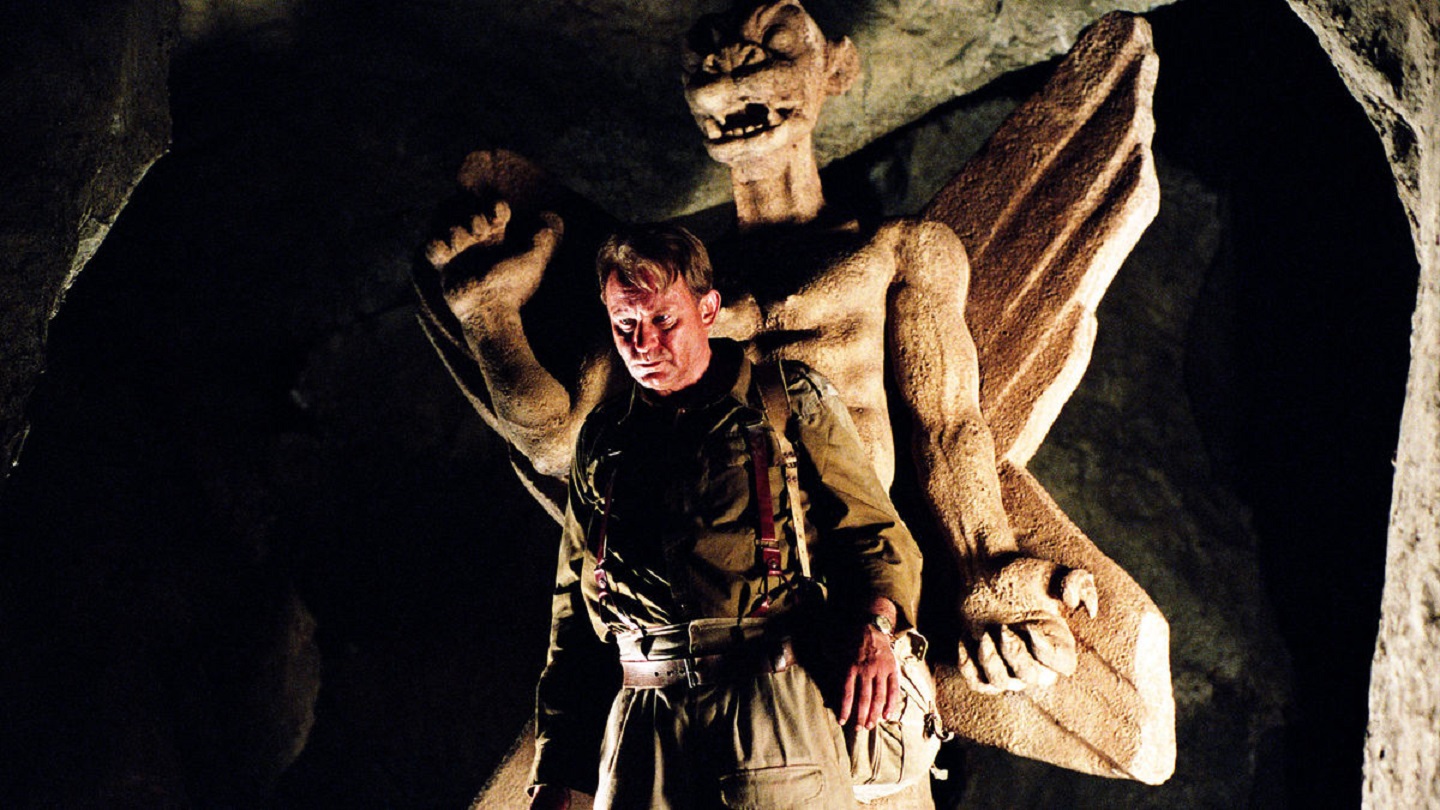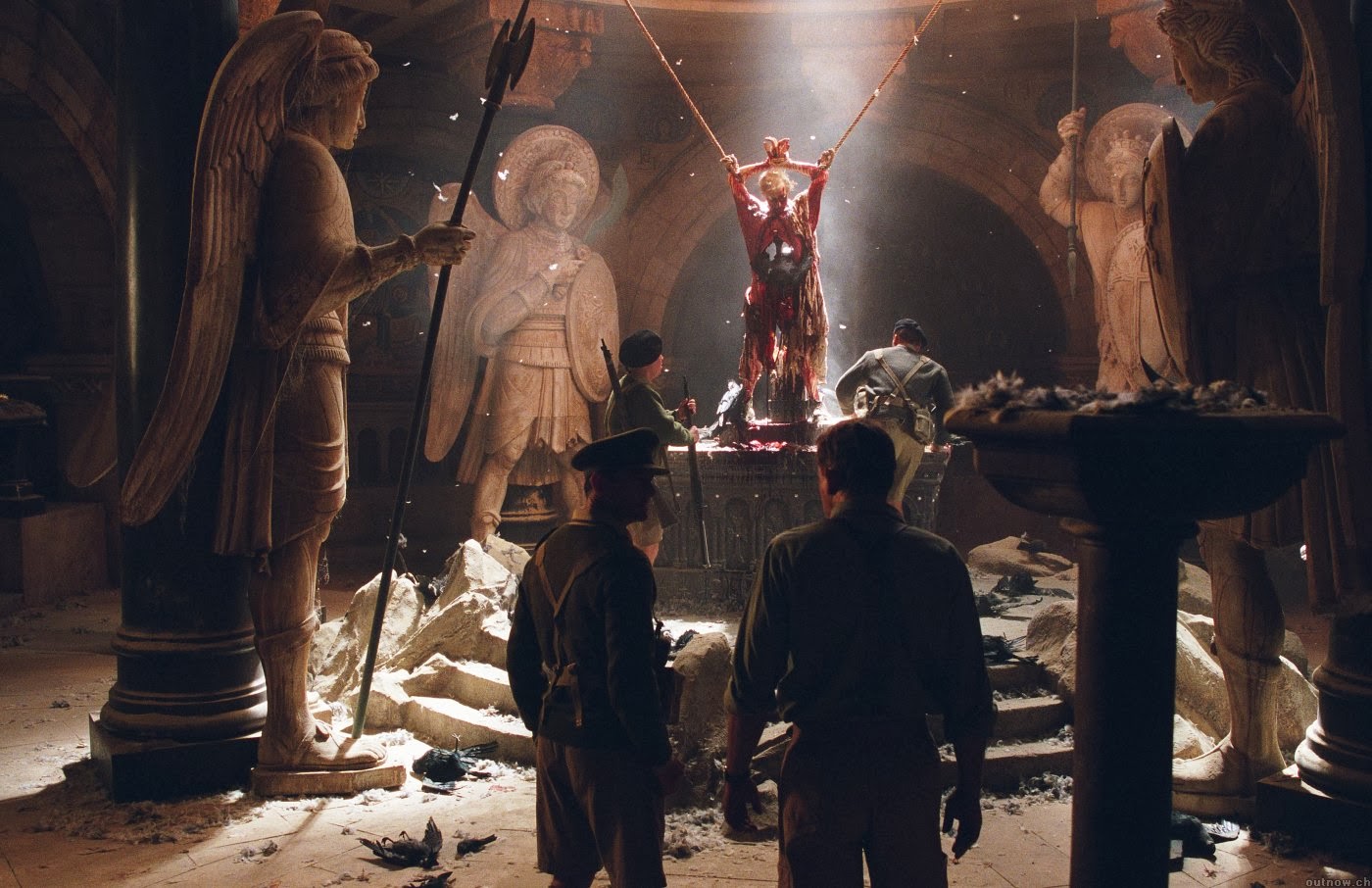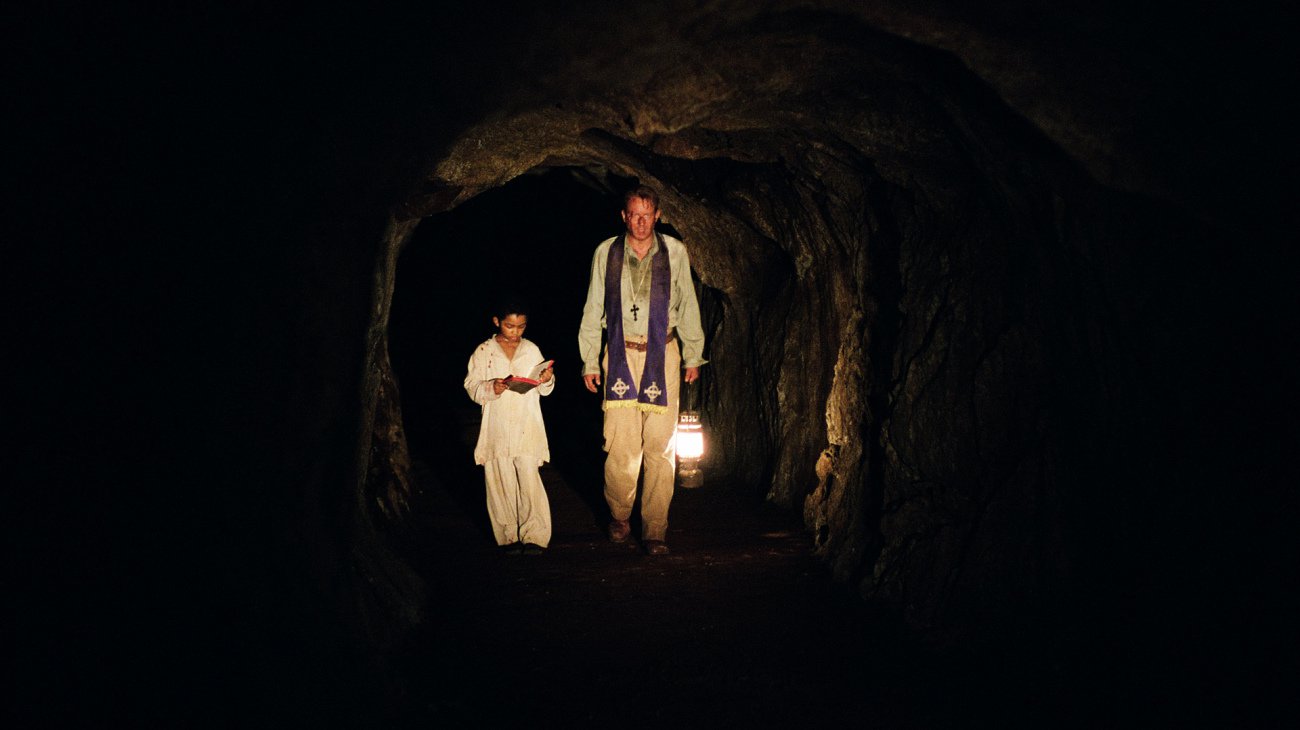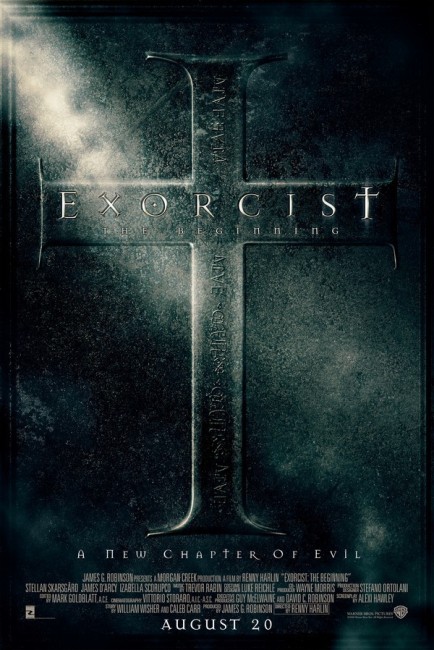USA. 2004.
Crew
Director – Renny Harlin, Screenplay – Alexi Hawley, Story – Caleb Carr & William Wisher, Producer – James G. Robinson, Photography – Vittorio Storaro, Music – Trevor Rabin, Visual Effects Supervisors – Brian M. Jennings & Ariel Velasco Shaw, Visual Effects – Digital Dimension (Supervisor – Benoit “Ben” Girard), Element Studios, Kleiser-Walczak (Supervisor – Tom Leeser), Meteor Studios (Supervisor – Richard Kidd), Pixel Magic (Supervisor – Ray McIntyre, Jr.) & Radish (Supervisors – Kenneth Littleton & Lawrence Littleton), Special Effects Supervisor – Danilo Bollettini, Makeup Effects – Gary J. Tunnicliffe’s Two Hours in the Dark, Inc. (Supervisor – Gary J. Tunnicliffe), Production Design – Stefano Ortolani. Production Company – Morgan Creek.
Cast
Stellan Skarsgård (Father Lankester Merrin), Izabella Scorupco (Sarah Novak), James D’Arcy (Father Francis), Remy Sweeney (Joseph), Alan Ford (Jeffries), Julian Wadham (Major Granville), Andrew French (Chuma), Eddie Osei (Emekwi), Ben Cross (Semelier), Patrick O’Kane (Bession), David Bradley (Father Gionetti), Antonie Kamerling (Lieutenant Kessel), James Bellamy (James), Cecilia Amati (Little Dutch Girl)
Plot
North Africa, 1949. Lankester Merrin is a former Catholic priest who has lost his faith after witnessing Nazi atrocities in the Netherlands during the War. He is approached to join the dig of a buried temple in Kenya being conducted under the aegis of the British military. Merrin is puzzled as to why there is a Christian church at the site, which dates from the 5th Century, hundreds of years before missionaries ever arrived. In the church, he finds that all the statues of Christ and the crucifixes are depicted upside down, while the native Turkana tribesmen call the site evil. Bession, the archaeologist who broke into the tomb has gone mad. When Merrin visits him, Bession slashes his own throat. The young son of one of the workers falls ill with a mysterious ailment and Merrin and the dig’s doctor Sarah Novak puzzle over the strange phenomena surrounding the boy. Merrin is reluctantly drawn back to the faith he has forsaken as he realises that he is confronting a demonic force.
It goes without saying that The Exorcist (1973) is a modern horror classic. It is almost certainly one of the two or three most influential horror films of the latter half of the 20th Century. Like most successes, it has been multiply sequelised. First, there was John Boorman’s disastrous Exorcist II: The Heretic (1977), which is widely considered one of the worst sequels of all time. William Peter Blatty, author of the original novel and screenwriter/producer of the first film, then made The Exorcist III (1990), a highly underrated film that this author at least regards as better than the original. Subsequently, there was also The Exorcist (2016-8), a tv series loosely based on the original featuring Geena Davis as a now adult Regan whose own daughter becomes possessed, and Blumhouse’s The Exorcist: Believer (2023) featuring the return of both Ellen Burstyn and Linda Blair.
Exorcist: The Beginning is a production that appears to be under a Devil’s curse of its own. It was originally announced in 1997 under Tom McLoughlin, director of Jason Lives: Friday the 13th Part VI (1986), and was shuffled around under various titles, including Exorcist: Dominion, Exorcist IV and The Exorcist 4:1. The film was not greenlighted until 2000 when a new tricked-up version of The Exorcist was released to theatres with unseen footage and proved to be a surprise success. Exorcist IV promptly made its way onto production schedules. A script was commissioned from Caleb Carr, author of The Alienist (1994), later the basis of the tv series The Alienist (2018– ), and a novelist specialising in military history, and screenwriter William Wisher Jr, best known as co-writer of Terminator 2: Judgment Day (1991). Original novelist William Peter Blatty was dismissive of Caleb Carr’s script; nevertheless Liam Neeson was signed on as Father Merrin and the director was announced as being John Frankenheimer.
Problems began in June 2002 when the completion guarantors refused to insure the 72-year-old Frankenheimer for shooting in Morocco. Frankenheimer bowed out of the production just before shooting was to begin, citing health problems (and died less than a month later from a stroke). Paul Schrader quickly took up the slack left by Frankenheimer’s departure. Paul Schrader is an interesting writer/director. He has directed a number of films, including the likes of Hardcore (1979), American Gigolo (1980), the remake of Cat People (1982), Mishima: A Life in Four Chapters (1985), The Comfort of Strangers (1990), Affliction (1997) and Auto Focus (2002). However, his best work has generally been among the screenplays he has written for Martin Scorsese – Taxi Driver (1976), Raging Bull (1980), The Last Temptation of Christ (1988) and Bringing Out the Dead (1999).

There are probably few directors better suited to an Exorcist film than Paul Schrader, so much so do the themes that preoccupy his works touch bases with the story that William Peter Blatty was originally trying to tell. Schrader comes from a strict Calvinist family and religious repressions underlie much of his work, while his films always concern individuals conflicted and tormented, usually in their sexuality. His version of Exorcist: The Beginning was purportedly one that focused on Father Merrin’s crisis of faith. More importantly, Schrader spoke of how his version of Exorcist: The Beginning was one that rejected projectile vomiting, head-turnings and crucifix masturbating and was a cerebral horror story. His inspiration had been to deliver something subtle and psychological, reportedly “along the lines of an M. Night Shyamalan film.”
Clearly, subtle and psychological cerebral horror was something that Morgan Creek were not wanting. Several months after Paul Schrader delivered his finished print to Morgan Creek, it was announced that he was departing from Exorcist: The Beginning over the usual ‘creative differences’. Much debate then centred around how to salvage Exorcist: The Beginning and give it more visceral horror. The initial idea had been to bring in another director to shoot additional scenes with Paul Schrader still retaining directorial credit. Finnish director Renny Harlin was auditioned. In an interview in The Times, Renny Harlin claimed that he was not interested in the job and suggested that they go and reshoot the film from scratch, not expecting that Morgan Creek would buy the idea, only to then find himself landed with the assignment.
A director at almost opposite extremes to Paul Schrader than Renny Harlin one might have some difficulty finding – maybe Michael Bay? Paul Schrader makes intelligent psychological films about driven and morally tormented individuals; Renny Harlin makes big and mindless action vehicles. Unlike Paul Schrader, Renny Harlin does have a beginning in horror films – he first appeared on the genre scene with his second film, Empire’s Prison (1987) and then went onto make the silly A Nightmare on Elm Street IV: The Dream Master (1988). From there, Harlin graduated to big-budget action vehicles such as Die Hard 2 (1990) and various Sylvester Stallone efforts like Cliffhanger (1993) and Driven (2001). He single-handedly managed to sink his ex-wife Geena Davis’s career after starring her in two bloated and absurd action movies that were total flops – CutThroat Island (1995) and The Long Kiss Goodnight (1996). Subsequent to Exorcist: The Beginning, Renny Harlin stayed with the horror genre to make the serial killer thriller Mindhunters (2004), The Covenant (2006) and The Dyatlov Pass Incident (2013), as well as The Legend of Hercules (2014). All of Renny Harlin’s films have been stupid and mindless, while everything he has made since Cliffhanger has been a box-office flop. The only watchable films among Renny Harlin’s oeuvre have been those in the so-stupid-they’re-entertaining category like the Andrew Dice Clay vehicle The Adventures of Ford Fairlane (1990) and the monster movie Deep Blue Sea (1999). Renny Harlin would, at least in this author’s estimation, rank alongside Michael Bay, Stephen Sommers, Jan de Bont and Joel Schumacher as one of the worst directors currently employed in Hollywood. It remains a thorough mystery as to why people like Renny Harlin who consistently make box-office flops that are hated by everybody still manages to get people prepared to give him lots of money to keep making films.

Renny Harlin was assigned to reshoot Paul Schrader’s film from scratch and make it scarier. Stellan Skarsgård was retained as Father Merrin, along with cinematographer Vittorio Storaro, but most of the other roles recast and newcomer Alexi Hawley was brought in to rework the script. Hawley’s script follows the basics of the Schrader film closely. Hawley’s major change is the introduction of the character of Izabella Scorpuco’s doctor, as well as the mad archaeologist Bession and a clear change of who the possessed person being exorcised is. Most of the other underlying conflicts of the Caleb Carr/William Wisher script is there – Father Merrin’s being haunted by Nazi atrocities in the Netherlands, the conflict between the Turkana natives and the British soldiers, and Merrin’s regaining of faith – although in this version there is little emphasis on the psychological/theological issues and much on the physical horrors. There is debate about exactly how much of Paul Schrader’s film remains in Renny Harlin’s version, with reports ranging from 10% to a couple of exterior shots of Morocco to none at all. The producers deemed themselves happy with Renny Harlin’s print and it was released. Although Morgan Creek, either having some misgivings about the film or simply fearing that the project was so haunted by bad press, refused to hold any advance screenings for critics. Not unexpectedly, critics and most of the audiences savaged the film, giving it some of the worst notices since, well, Exorcist II: The Heretic. Paul Schrader’s print languished in Morgan Creek vaults, before being eventually released as Dominion: Prequel to The Exorcist (2005) – see that link for detailed comparison between the two films.
Based on advance word and my dislike of almost every film that Renny Harlin has made, I went into Exorcist: The Beginning with critical knives readied to skewer it with the most contemptuous turns of phrase that I could think of. I must say I came away somewhat disappointed. In fact, Exorcist: The Beginning almost ends up being a halfway watchable film. I might go out on a limb so far as to say that Exorcist: The Beginning is possibly the best film that Renny Harlin has made – at least in the sense that it is the most dramatically convincing and the least ridiculous and over-the-top. In the end, Exorcist: The Beginning is not anything more than a routine horror film, although one suspects that if it were made as a stand-alone film and did not come with any attachment to the Exorcist franchise it might have gotten a more average reception.
Renny Harlin’s virtue is Vittorio Storaro, who also shot the likes of Apocalypse Now (1979), Ladyhawke (1985) and most of Bernardo Bertolucci’s films. Storaro gives the Morocco landscapes a burning widescreen beauty. The set designers do an excellent job of making the settings look like North Africa in the 1940s. Stellan Skarsgård gives a dour conviction to Father Merrin – he actually looks like a young Max Von Sydow (in fact, the two actors both come from Sweden).

Renny Harlin’s ultimate failing is that Exorcist: The Beginning, while technically very polished, is only a routine and formulaic horror film. All that Renny Harlin delivers are pop-up scares – hyenas tearing a boy apart, a man slitting his throat with a shard of mirror, a body partially gored to the skeleton and a woman delivering a baby crawling with maggots. You cannot deny that Renny Harlin manages to provide a couple of jumps on occasions but there is nothing amid these that does not seem in any way not a cliché or borrowed from another film – clocks that stop ticking, crucifixes that insist on turning upside down, blood flowing back into iv tubes, mysterious winds, prowling hyenas with glowing eyes, people with oozing sores on their faces, the crosscutting of a birth scene with an archaeologist hammering into a tomb that has been lifted from The Awakening (1980). Other effects like Izabella Scorupco waking up to find Alan Ford in bed with her seem silly. Even the familiar parts from The Exorcist – shaking beds, spider walks and head turnings, various verbal obscenities – are reduced to little more than pop-up effects that fail to raise the slightest frisson. These might have been competent fare for a direct-to-video horror release but when one remembers just how groundbreaking and taboo-defying The Exorcist was, they seem tame in extremis. For all Morgan Creek’s belief that audiences want to see a parade of horror scenes, the film on show here does not even in the remotest way challenge its R-rating or the taboo lines that the original did.
Expectedly, the theological and psychological issues that were to the forefront of Paul Schrader’s version have been sidelined in this version. Exorcist: The Beginning is a film that has been made with a surface competence but no depth beyond that. While Renny Harlin touches base with Father Merrin being haunted by the spectre of Nazi atrocities, these flashbacks feel like cod character motivation – of filmmakers reaching for Nazi atrocities when they suddenly wish to give an instant injection of total evil that needs no further explanation. Izabella Scorupco’s character has been thrown in for the sole purpose of giving Merrin some sexual temptation but other than a single kiss, this is an entirely negligible element. The film even throws out almost all continuity to the original film. About the only thing we know about Father Merrin’s past from the first film is that he was nearly killed while conducting the exorcism of a young boy in Africa – and, while this film is at least set in Africa, Merrin neither exorcises a boy nor is he ever nearly killed.
The result is a disappointment. A large part of the problem is Morgan Creek, whose attitude since purchasing the Exorcist franchise has been to regard it as little more than another horror series akin to the endless Halloween and Friday the 13th sequels. William Peter Blatty faced the same problem that Schrader did when he made Exorcist III and delivered an excellent and hauntingly spooky film, only for Morgan Creek to demand reshoots to make the ending more visceral. The same happened with Exorcist: The Beginning, where it seems the only thing understood by Morgan Creek executives is horror shock effects. Such represents a clear misunderstanding of the current box-office trends. This is no more clearly represented than looking back to 1999-2000 when we saw a host of films that tried to do variants on The Exorcist redressed with modern horror effects – the likes of End of Days (1999), Stigmata (1999), Bless the Child (2000) and Lost Souls (2000). These proved box-office failures, while horror that season was instead dominated by the runaway successes of The Blair Witch Project (1999), The Sixth Sense (1999) and The Others (2001), which showed that, unlike Morgan Creek’s estimation, audiences had a clear and overriding preference for cerebral and understated horrors.
Trailer here

